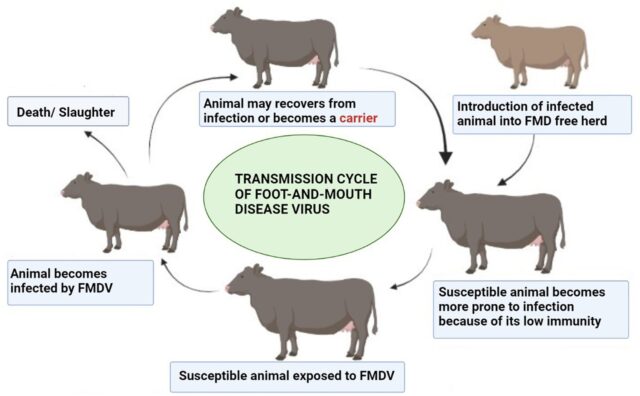Foot-and-mouth disease (FMD) is a significant viral disease affecting large ruminants in India, affecting cattle, buffalo, and pig populations. It causes severe symptoms like high fever, excessive salivation, and decreased milk yield. The disease is caused by the Foot-and-Mouth Disease Virus (FMDV) and is highly contagious, causing higher morbidity and mortality rates in susceptible populations.

The genetic material of the virus is ribonucleic acid (RNA).FMDV infection in India dates back to 1864 and has been reported in various parts of the country. Four of the seven known FMDV serotypes were reported in livestock in India before 1995, with type O reported in 1944, type A in 1959, type C in 1955, and type Asia1 in 1951.India had not recorded FMDV serotype C since 1995 due to quadrivalent vaccination and unexplained reasons. Currently, only three serotypes (O, A, and Asia1) are reportedly circulating in the livestock population of India. Inactivated FMDV vaccines are available in the Indian market, and routine vaccination is the best way to achieve protective antibody response against FMD in vaccinated animals.
Foot-and-mouth disease control programme in India
The Indian government has initiated a progressive control pathway for Foot-and-mouth Disease (FMD) following protocols from the Office International-des-Epizooties (OIE)/Food and Agriculture Organisation (FAO) to reduce losses in susceptible livestock populations. The nine major activities that are being undertaken in the FMDCP are:
- To vaccinate cattle and buffaloes at six monthly intervals.
- Publicity and mass awareness campaigns.
- Identification of target animals.
- Sero-surveillance and monitoring of animal population on random basis.
- Mass vaccination.
- Procurement of cold cabinets and vaccine.
- Quality assessment of randomly collected samples from vaccine preparations.
- Typing of FMDV in case of outbreaks.
- Recording/regulation of animal movement from unvaccinated areas.
The FMD vaccine, administered at six monthly intervals, is being tested to determine if it elicited a protective immune response in vaccinated large ruminants. Serum samples are collected from randomly selected 10 villages in each district, including cattle and buffaloes, after every vaccination. Around 400 samples are tested from each district to evaluate if the vaccine elicited enough neutralizing antibody response and protection to prevent future FMD outbreaks. India has around 733 districts, and data for two subsequent years 2017-2018 and 2018-2019 is needed to arrive at the appropriate level of protective antibody response. However, early workers noted the weakness of national eradication schemes in India, as testing data for cattle and buffaloes from randomly selected villages is unavailable.
Vaccines and vaccination for Foot-and-mouth disease in India
The Directorate of FMD in India is responsible for continuous surveys, monitoring, and collection of clinical samples for virus typing and isolation from susceptible livestock populations during disease outbreaks. The national FMDV repository has 2,188 FMDV isolates, which are used in genotyping studies and vaccine matching experiments. Vaccines are an important tool in controlling FMD in India, with trivalent inactivated FMDV vaccines currently used in immunization programs. India is continuously working to increase its capability to produce sufficient doses of FMD vaccines required for FMDCP to cover vaccination of small and large ruminants and pigs. Private vaccine manufacturers like Intervet, Biovet, and Brilliant Biopharma Pvt. Ltd. are ramping up the production of doses to cover domestic needs and export to demanding countries. The Government of India extends financial help to Indian states for procurement and administration of vaccines to the susceptible livestock population for prevention of FMD. During FMD outbreaks, economic losses can be up to 80.68% due to reduced milk yield. To contain these losses, vaccination to susceptible livestock populations is necessary. India ranks first in milk production (176.3 million tonnes in 2017-2018). Rapid diagnostic testing kits allow early detection of FMD, aiding in devising preventative and control strategies. However, critics argue that there is over 20% reactivity to FMD non-structural protein (NSP) 3AB3 indicative of FMDV exposure in field animals, indicating poor vaccine quality. Despite these challenges, FMDCP in India has achieved success in reducing FMD outbreaks.
Reduction in Foot-and-mouth disease outbreaks reported in India
The Foot-and-mouth Disease Control Programme (FMDCP) in India has seen a significant reduction in FMD outbreaks from 2002-2012 due to comprehensive sero-monitoring, epidemiological investigations, increased diagnostic capabilities, trained manpower, and vaccine manufacturing capacity. The National Animal Disease Control Programme (NADCP) was launched in 2019 to vaccinate 600 million animals to control FMD and Brucellosis. However, there are criticisms, such as the underreporting of FMD incidence in states. To increase transparency, the processes of vaccinations, blood collections, and follow-up should be recorded digitally, and location tracing applications can be developed to monitor actions of vaccinators and workers. Monetary incentives for reporting the incidence of the disease can also help prevent and control it. To spread awareness among common man and livestock owners about the FMDCP, more coverage by print and press media is needed. Additionally, addressing the epidemiology and transmission of the disease in a better way can help address concerns among animal owners. In conclusion, the FMDCP is a crucial initiative in India’s fight against FMD, but it requires further efforts and awareness to ensure its effective implementation.















